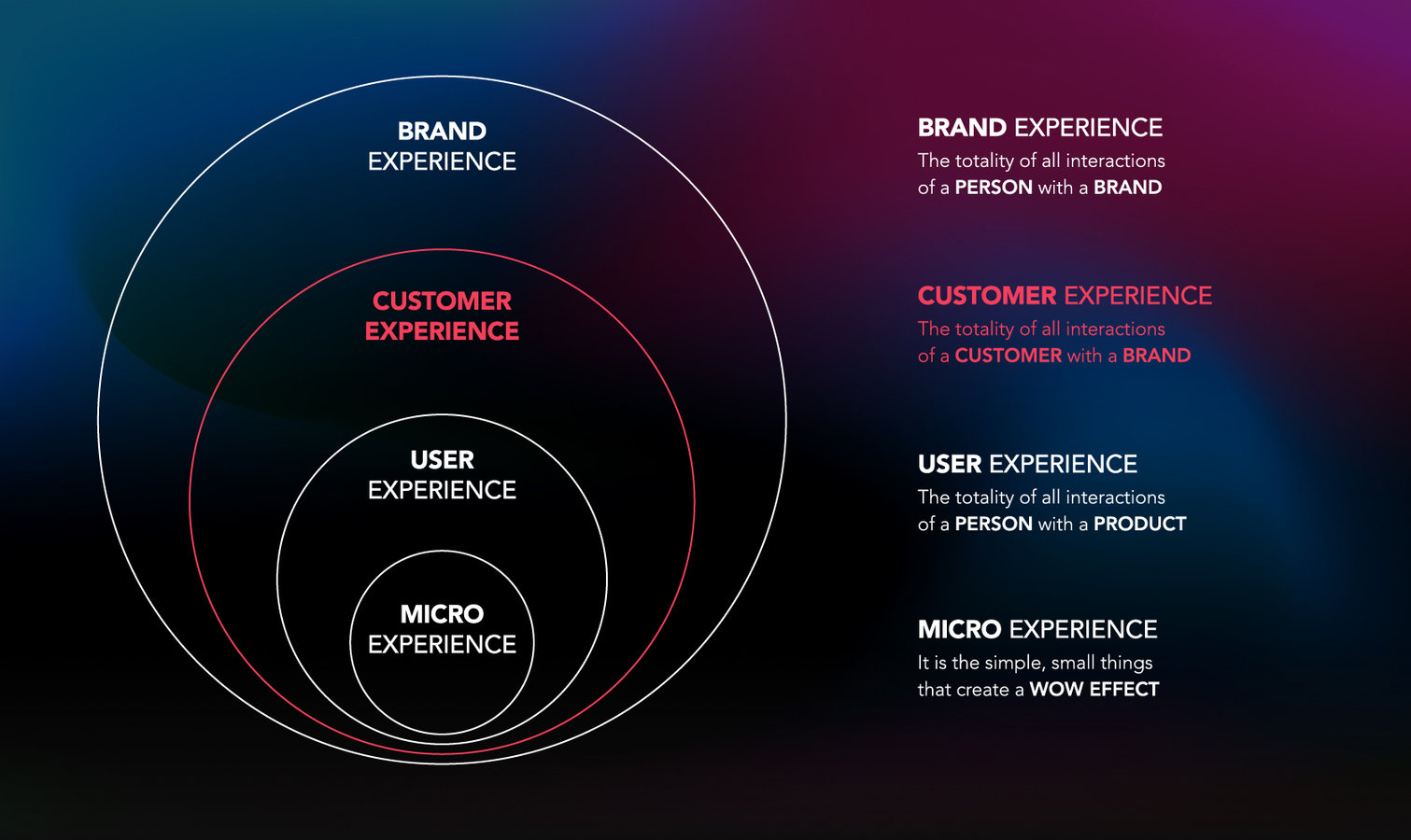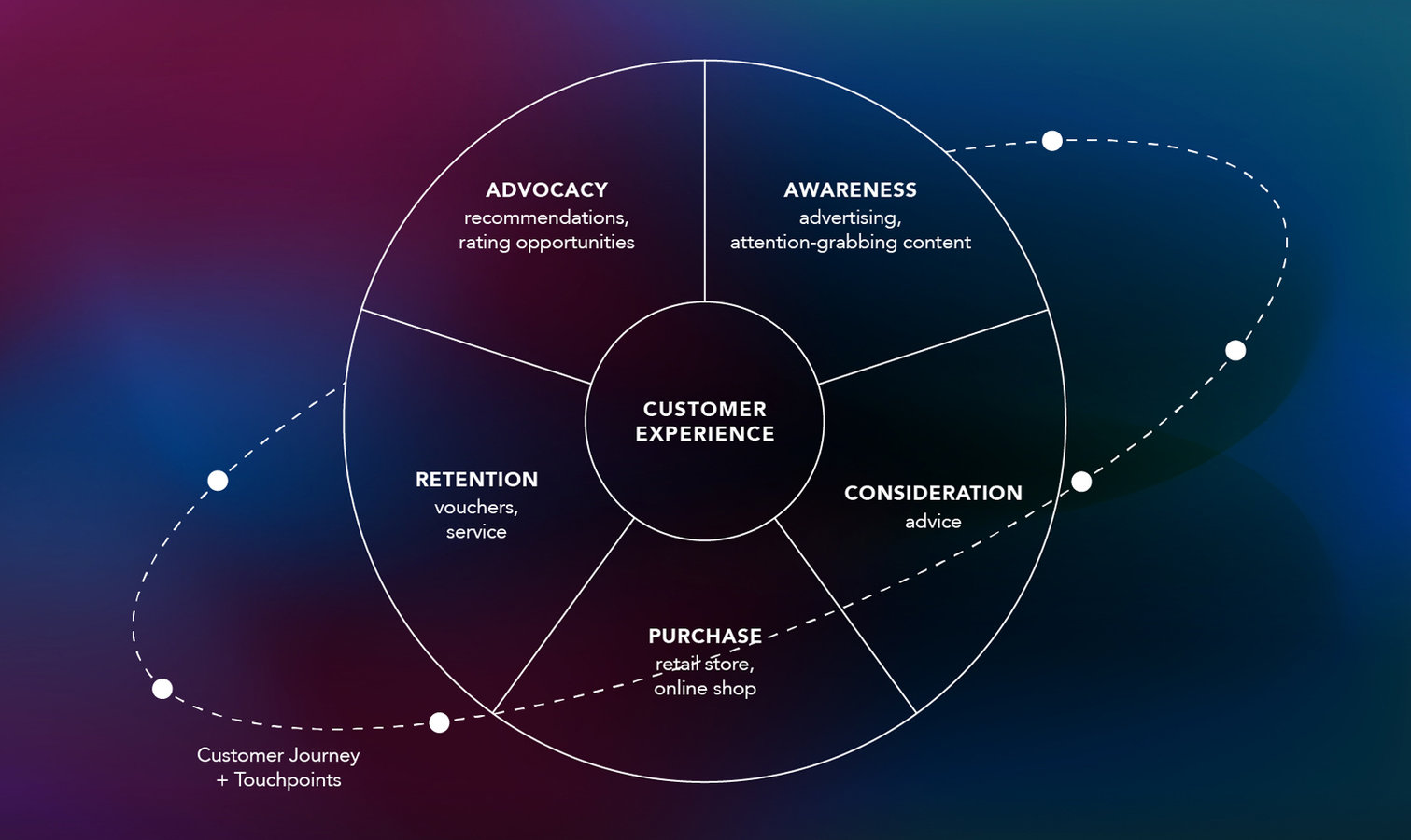Expertise
DIGITAL CUSTOMER EXPERIENCE

The customer experience can be understood as a sub-area of the brand experience as a whole. While the brand experience encompasses all experiences and interactions of a person with a brand - regardless of whether this person becomes a customer or not, the customer experience explicitly refers to "the totality of all impressions that a customer receives from a company during the entire duration of a customer relationship" (Gabler Wirtschaftslexikon). This means that the customer experience is the individual perception of the customer during all interactions with the company that offers his or her desired product or service for purchase. This refers to all possible touchpoints before, during and after the purchase, which can occur in the course of the decision-making, consultation and purchase process and, if applicable, the return, complaint, support or evaluation process and, of course, also the sum of the customer experiences in the case of multiple purchases. In addition to price and quality, the customer experience is a decisive competitive factor for companies in both stationary and online retail, in order to win over consumers and retain their loyalty in the long term.
Good customer experience management is characterised by the fact that it knows and responds to the individual needs and emotions of customers along the customer journey. The top priority should be to give the customer a good feeling at all times and to generate positive emotions.
As soon as a person buys a product or service, they become a customer. This interaction with the company is always linked to an experience. The customer experience therefore always takes place - regardless of whether the company has a strategy for it or not - and can be positive or negative. Companies should not leave the customer experience to chance! The pandemic exceptional situation has not only accelerated the digital transformation, but in this context has also changed the buying habits of customers. Society is currently more experience-oriented than ever before because it has had to accept many restrictions, which led to enormous pent-up demand. Especially in online retail, the variety of offers seems almost limitless, but the providers often seem arbitrary. What is the deciding factor for customers to buy?
As a company, it is important to stand out from the crowd. The special and the unmistakable USP (unique selling proposition) come to the fore. Of course, this has to be communicated. In this context, the company's own website and accompanying social media channels are indispensable. The customer experience is increasingly becoming a decisive competitive factor because customers like to buy where they associate a consistently positive and memorable experience with the purchase. For example, the retailer can score points with competent and friendly advice, short waiting times, technically smooth processing or even small attentions (vouchers, discounts, sweets/activities for the children, coffee, ...). If the provider succeeds in charging the buying experience with positive emotions, an emotional connection of the customer to the company and its products or services is created. This results in a competitive advantage that is difficult to imitate by the competition. It is crucial to always be aware that the customer experience takes place in every purchase phase of the customer journey and therefore affects the most diverse touchpoints ( cf. graphic). Only those who have the entirety of this process in mind can achieve a consistently positive emotional charge of the customer experience through appropriate measures.
A positive customer experience is the precursor to long-term customer loyalty. Customers who feel comfortable come back and also act as multipliers - be it through recommendations in their immediate environment or through positive online reviews.

Increasing digitalisation makes it necessary to link the offline and online worlds more closely. Traditional business models must evolve to remain profitable. Their reach can be extended, for example, with a corporate website, online shop, customer portal and digital newsletter communication. But online retail can also create additional awareness through classic corporate appearances such as television or print advertising. An omni-channel approach is advisable, which generates attention on different channels and directs interested parties specifically to a digital content hub - for example the company website - in order to minimise duplication of effort and loss of information. The use of digital communication channels for customer communication increases efficiency and creates new opportunities for customer loyalty. The modern buyer is well connected and uses mobile devices as a matter of course. In this respect, they not only expect digital offers and contact points, but also presuppose them, which is why the digital customer experience now plays an important key role.
The digital customer experience is the totality of all experiences that a customer has during digital interaction with a company. It is characterised by digital information processing, digital communication and the functionality of the corresponding interfaces.
The biggest challenges of Digital Customer Experience Management (DCXM) are the increase in potential touchpoints, especially through new media channels, as well as the need for comprehensive accessibility - and that beyond shop closing hours. In addition, users expect consistency across all channels. Excellent service is of enormous importance: it allows the company to differentiate itself from the competition and to be remembered positively with its brand. According to the study "State of the Connected Customer" (Salesforce, October 2020), customers are four times more likely to leave for a competitor if there is a problem with the service (and not with the product or price). To meet service expectations, measures must be implemented to provide positive experiences for all customers at every possible interaction point. It should be possible to synchronise the data obtained in the system to facilitate future orders.
It is particularly important to present the products and services offered in such a way that there is an additional emotional benefit. Salesforce predicts that in the future 67% of customers will be willing to pay more for an outstanding experience. The lifetime value of a brand increases by 306% when customers have built an emotional connection to it. Likewise, the possibility that the brand will be recommended to others increases from 45% to 71%.
Checklist: Customer experience step by step
1. Status quo
How do your customers currently feel about the digital customer experience offered by your company? Existing customers can best answer this question themselves via the feedback function. It is also advisable to ask service employees who are close to the customer. Define KPIs (key performance indicators) that make the quality of the digital customer experience measurable, e.g. shopping cart order cancellations etc.
2. Target group
Which target group do you want to reach? Do you actually address them with your current presentation? If you know who you want to win over as buyers with your product or service, the next step is to define the corresponding needs, behaviours and motivations. We are happy to support you in analysing your target group and developing buyer personas.
3. Analyse the customer journey
What journey do your customers take until they sign a contract? At which touchpoints do they come into contact with your company and your brand? We identify important key moments for you.
4. Uncover weak points
Based on the data obtained, problems become visible and weak points become clear. At which points in the customer journey are your offers not meeting customer needs?
5. Continuous optimisation
In close cooperation with you, we design measures to improve the digital customer experience. We prioritise the individual implementation points in line with your corporate strategy. Since requirements can change quickly over time, we implement feedback functions and the technical basis for recording important KPIs so that the digital customer experience of your customers continues to be positive in the future.
Companies that want to survive on the market in the long term are aware of the following changes: Digitalisation has triggered a change in market and competitive conditions. In addition, consumer behaviour has changed. Recommendations are becoming increasingly important. The proportion of people who choose their products based on positive testimonials from relatives or acquaintances has grown significantly in recent years. Individual expectations and wishes are becoming increasingly important for buyers. They therefore expect companies to provide them with customised offers and flexibility. Consumers want to get value for money, so they are receptive to emotional and experiential appeals before, during and after the buying process. An optimal customer experience, digital or on-site, has become a decisive competitive advantage. Successful companies rely on:
- outstanding, high-quality products
- consistently communicated brand experiences across all channels
- straightforward ordering processes and secure payments
- excellent service with comprehensive accessibility
- target group knowledge and satisfying the experience orientation of their customers by emotionally charging the functional features of their product or service
The effort to always keep the customer experience in mind during the buying process pays off in many ways. Because a positive customer experience is reflected in the following points, among others:
- intensive customer loyalty
- competitive advantage through differentiation from the competitors
- high recommendation rates
- low churn rates
- low shopping cart abandonment rates
- higher lifetime customer value
- higher brand value
- lower service costs due to reduced need for complaint management